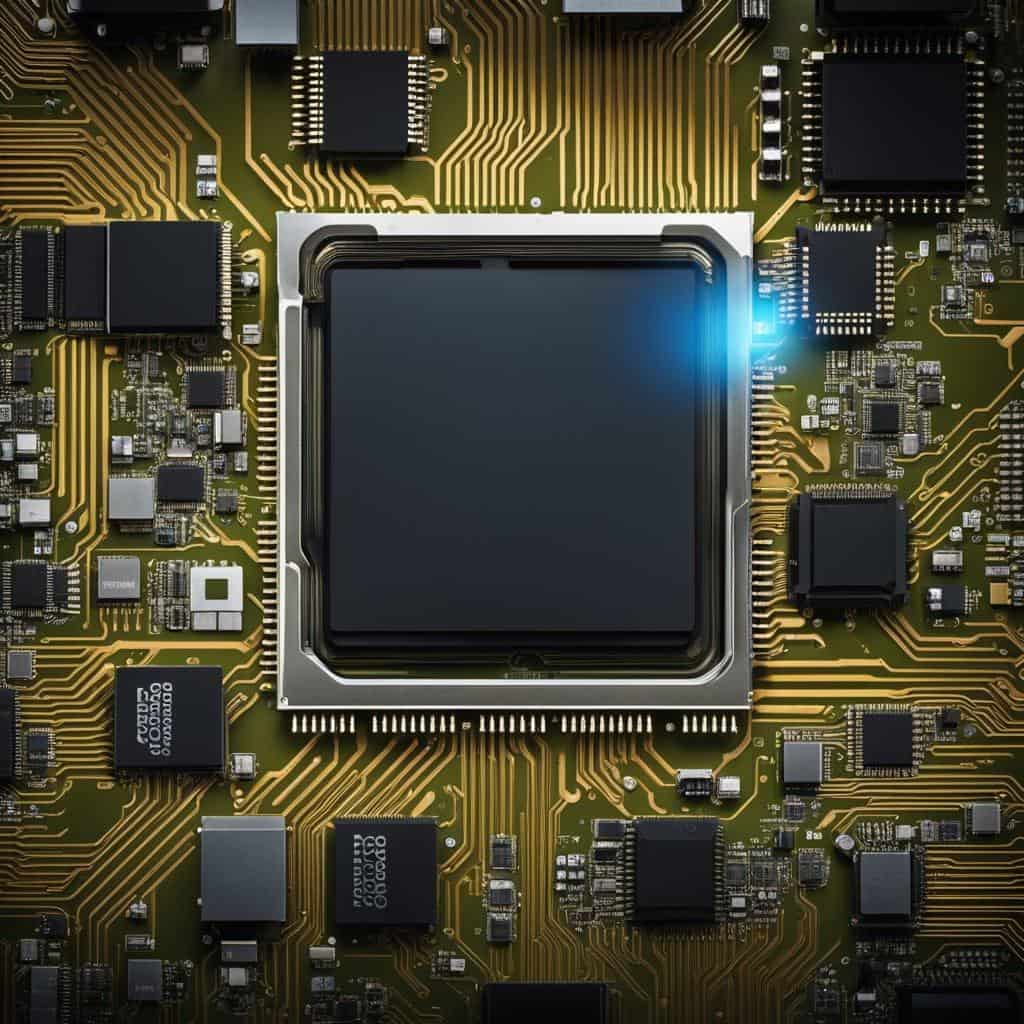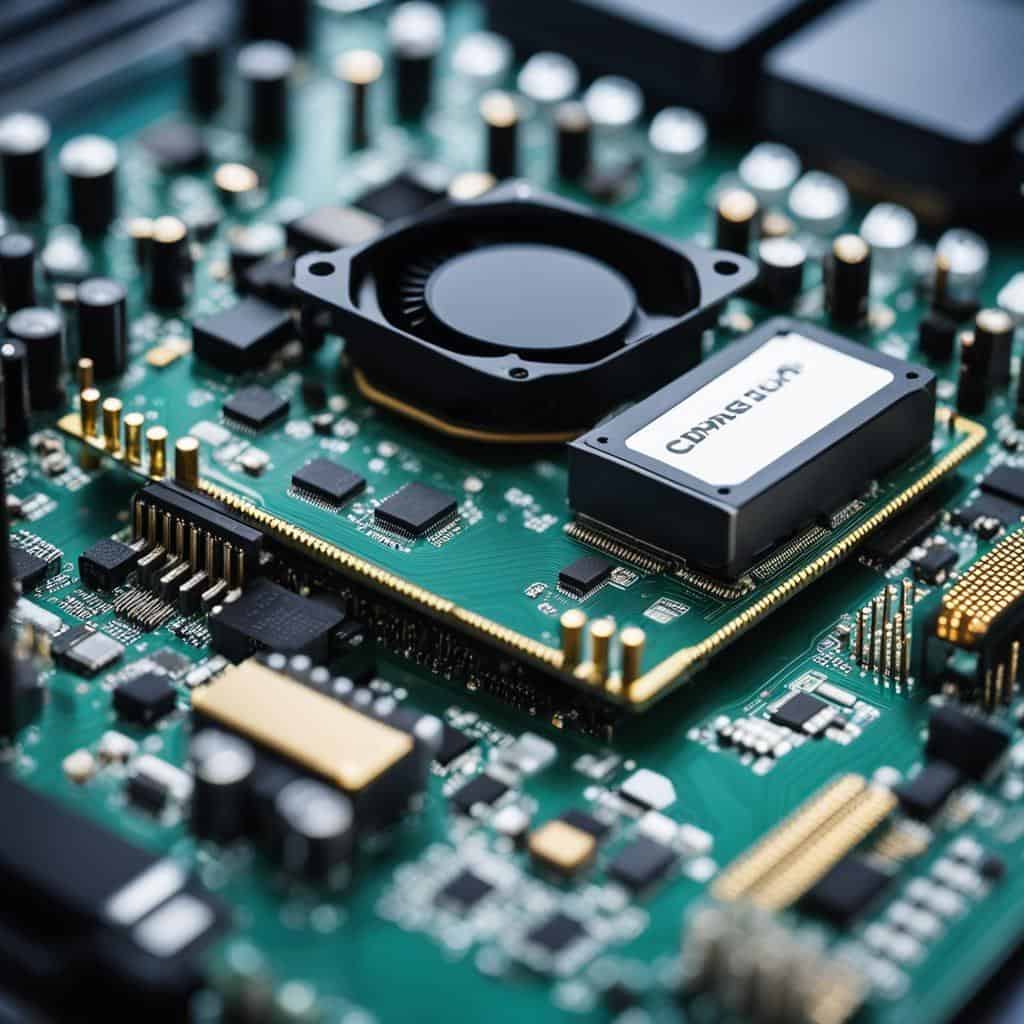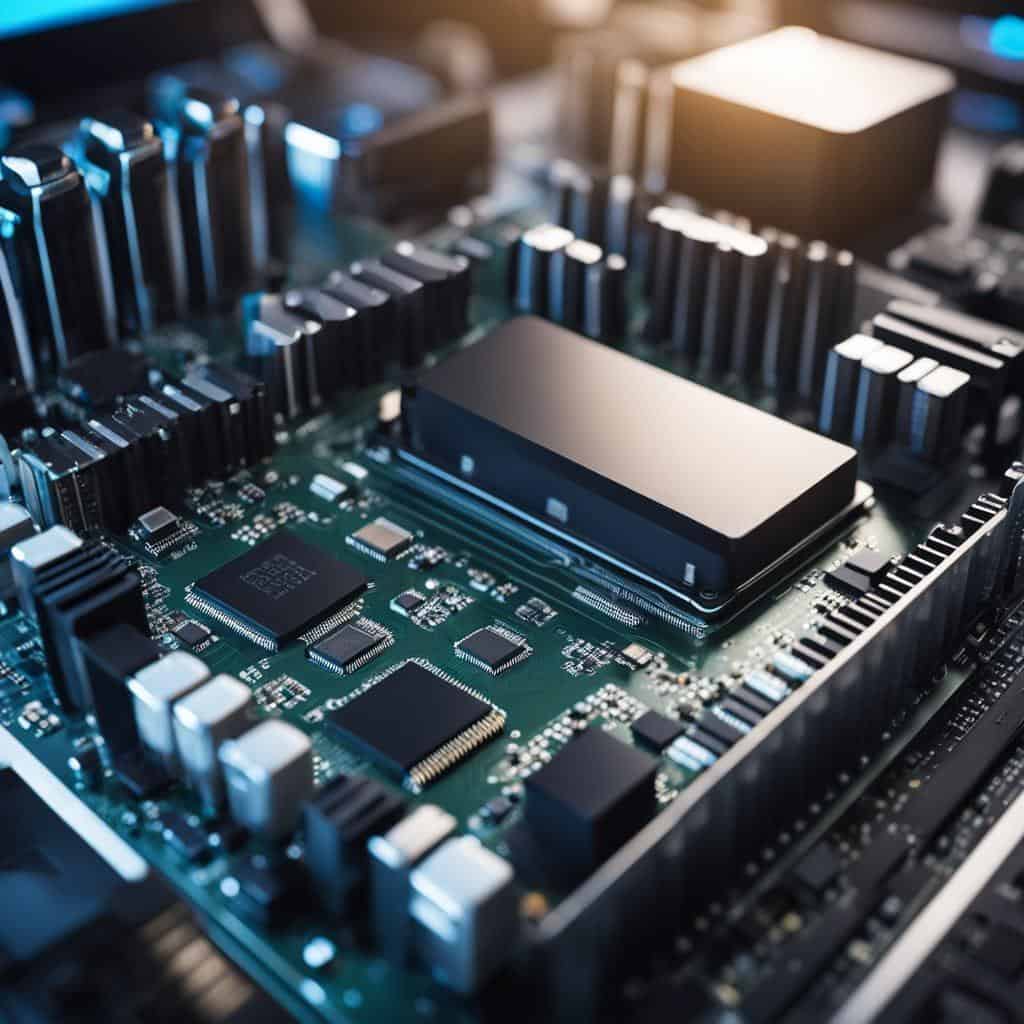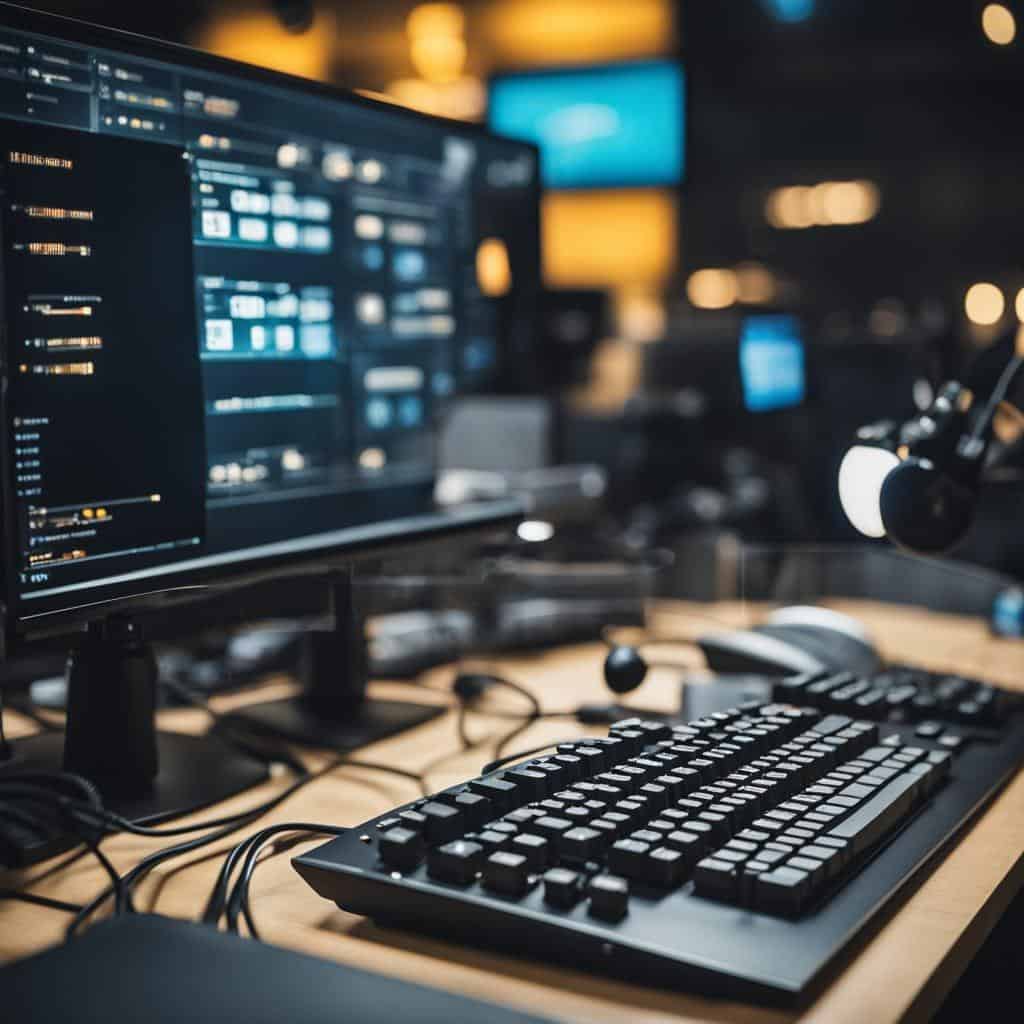TL;DR:
- Major components of a computer include the central processing unit (CPU), clock speed, cache memory, motherboard, and random access memory (RAM). Higher clock speed and more cores increase data processing ability. More cache enhances performance.
- Solid-state drives (SSDs) offer quicker data access than hard disk drives (HDDs), but are more expensive.
- The cooling system in PCs uses air or liquid to prevent overheating. High-end systems can benefit more from liquid cooling.
- Building a custom PC requires a clear purpose, an understanding of hardware compatibility, and thorough planning.
- Computer hardware evolution has seen processors go from single-core to multi-core, and new types like ARM chips have emerged. Regular maintenance of the PC is crucial.
- Hardware benchmarks help determine computer performance. Overclocking can enhance performance with adequate thermal management.
- Primary (RAM) and secondary (hard drive or SSD) memory differ in volatility and speed.
- Future developments in computer hardware include VR-ready hardware, AI-dedicated chips, faster PCI versions, quantum computing, and sustainable components.
- For high-end graphical and video editing tasks, powerful and customizable desktop hardware is recommended.
Ever wondered what makes your computer tick? Our comprehensive guide “Explaining Computer Hardware: What Do You Need to Know?”, breaks down the maze of hardware terms into chewable chunks. We’ll delve into everything from the core essentials like CPUs and motherboards to futuristic advancements. Trade bewilderment for expertise and empower yourself to make informed choices in your tech journey. Prepare to unlock the secrets of hardware and turn tech-speak into your new language!
What are the main components of computer hardware?
Let’s dive deep into the core of your PC. Think of it as understanding the computer’s anatomy. Essentially, our journey will involve getting a basic computer components breakdown and understanding what makes up a computer.
The central processing unit (CPU) is the brain of the computer. We call it the processor. Every data bit rides a speedy highway to its part in the system. The CPU decides the motion. Two major types are around. One is x86 from the Intel family. AMD also uses this type. Yet, ARM rules in mobiles and even Apple’s M1 computers.
Clock speed is the CPU’s pulse rate. It can vary from 1.5GHz to 5GHz. It determines how much data can be processed at once. The count of cores also hitchhikes on this processing task. It chips in to manage more tasks at once. Modern tech even features cores of differing performance. The Intel ‘E’ and ‘P’ cores is an example.
To buffer data flow with RAM, the CPU carries cache memory. Categorized into levels 1, 2, and 3 – the fastest being level 1. More cache helps with better computer performance.
Another worthy mate of the system is the motherboard. It houses critical components and allows communication among them. RAM (random access memory), plugged into the motherboard, is another vital piece. It holds data that is accessed randomly by the CPU. More RAM means your system can handle more open apps or data files at once with ease.
Thus, these are some of the basic computer components that make your computer come alive. Learning to understand PC hardware helps us appreciate the technology and even troubleshoot computer issues. Stay tuned, as we will dive deeper into other topics to help build your computer anatomy knowledge.
What differentiates SSDs from HDDs?
If you’ve used a computer, you’ve used either an SSD or HDD for storing data. That’s their job. But how are they different? Sit tight; let’s unravel the SSD vs HDD mystery.
When picturing an HDD, recall an old record player. It has a head and a spinning disc. Info is stored in tiny bits on the disc. As the disc spins around, the head reads these bits. Simple, right?
However, there’s a downside. The spinning disc can slow down data access. Imagine waiting for your favorite song to come around on the record. That’s an HDD in action.
On the other hand, an SSD, or solid-state drive, stores data on microchips similar to a USB stick. There is no disc or head, which makes accessing data much quicker and quieter (trust me, your ears will thank you!).
But you’re wondering, “Why isn’t everyone using SSDs?” Right. Well, SSDs tend to be more expensive than HDDs, which can influence your decision when purchasing a new computer.
The bottom line? If you need faster access to data and don’t mind spending a bit more, SSDs are the way to go. For storing large amounts of data on a budget, an HDD can be a great choice.
Now, you’re no longer in the dark about the SSD vs HDD battle. Remember, the ultimate choice comes down to your specific needs and budget.

How does the cooling system function in a PC?
Your computer is a hot rod. No, the insides can get really warm! When you push your PC’s engine (a.k.a the CPU) with an intense game or some heavy photo editing, it heats up like a car engine. This is where the cooling system in PCs comes into play.
“Just like a car?” you might ask. Yes, my dear reader! Think of the cooling system as your PC’s air conditioner. Its job is to cool down the hot parts inside your device. This system can use air or liquid to keep things chill. Both methods have their pros and cons.
“Air or liquid, that sounds like a hard choice.” Well, it can be. Air cooling is the most common. It uses a fan to push hot air out and pull cool air in. Simple, right? But there’s more. There’s also a heat sink, a big, hunk of metal that helps spread out the heat.
Liquid cooling? It’s like the spa day of the PC world. It uses water or another liquid to cool down your hot parts. It moves the hot liquid away from the internals and back to its cooled state. It takes more work to set up but can offer better cooling for high-end systems.
“What about my other parts?” Glad you asked! Other parts like your graphic card and power supply also generate heat. Fear not as these parts often come with their built-in fans.
“How do I know my PC is too hot?” Your PC likely has sensors to keep an eye on temperatures. If things get too hot, it can slow down performance to cool off or shut down to prevent damage.
In summary, the cooling system is your PC’s unsung hero, hustling in the background to keep your device from overheating. So next time you’re leveling up in your favorite game without care, remember to thank your trusty cooling system. It’s working hard to keep things running smoothly.
What are some considerations for a custom PC build?
Building a custom PC can feel like a big project. Don’t worry though! Your pal here is going to help.
First off, you need to decide why you want a custom PC. Are you a gamer needing top-tier hardware? Perhaps, you’re a professional needing a workstation with specialized components. Or maybe you’re just a beginner wanting to dive into the world of PC hardware.
For gamers, the sheer brute force of your hardware matters most. You’ll want a burly CPU (Central Processing Unit), lots of RAM (Random Access Memory), and a high-powered GPU (Graphics Processing Unit). Consider checking out our deep dive into computer internal parts for more details.
Workstation users, on the other hand, need a more balanced approach. You want a system that’s good at pretty much everything. Opting for a solid CPU and ample RAM is still crucial but don’t overlook elements such as storage and connectivity options. See the guide on performance tuning of hardware to find that sweet spot.
Lastly, any PC builder should learn about hardware compatibility and standards. Motherboards, processors, and other parts all need to speak the same language to work well together. Thankfully, it’s not as complex as it sounds. To make things easier, check out our discussion on hardware compatibility and standards for more detailed information.
Remember, build according to your needs and you’ll end up with a system that’s perfect for you. Plus, the learning you gain along the way might just spark a new passion for PC hardware!
How has computer hardware evolved over the years?
Computer hardware has come a long way. Back in the day, we had huge, bulky machines that didn’t do much. Today, our devices are slim and fast. They can answer almost any question in an instant. So, how did we get here?
First up, let’s talk about the brain of the computer, the processor.

In the past, we had just one core in a processor. That means it could only do one thing at a time. These days, we have many cores. Each core can do a task on its own. This lets us do more at once. Processors now have a thing called a “cache”. This is a small bit of memory used to store things the processor uses a lot. This means it can get to these things faster.
Next, let’s dive into the types of processors. We have x86 and ARM. x86 is the old guard. It’s been around for ages and is often used in desktops and laptops. ARM is the newcomer but it’s making a big splash. Most phones and tablets use ARM chips. Now even Mac computers use them.
Now, let’s not forget about upkeeping our parts. Just like you take care of your car, you should also look after your tech. You should clean your PC and keep it in a cool, dry place. This stops it from getting too hot, which could slow it down. Also, if your PC does break, don’t fret. There are often easy ways to fix it, like swapping out a part.
So, that wraps up our stroll down memory lane. Hardware is always changing. It’s exciting to think about what could come next. From faster CPUs to even smaller parts, the only limit is our creativity. And maybe physics.
What are hardware benchmarks and how are they useful?
Let me share a bit about hardware benchmarks. They are tests that check your computer’s performance. Think of them as a report card for your computer. But why do you need them? Well, they help in determining the quality of your computer hardware.
You’ve probably heard of overclocking as a way to boost performance. In a nutshell, it’s like turbocharging your car. It can help you squeeze out some extra speed, but you need to be careful with thermal management. Overclocking tends to warm up your computer, so high-quality cooling is a must!
Now, thermal management is all about controlling the heat in your computer. You may use fans, heat sinks, or even liquid cooling to tame the heat. It’s like ensuring your car doesn’t overheat when you’re racing at top speed.
When building a computer, many use checklists. These are like a cook’s recipe, listing all the needed parts. A good build checklist can help ensure you don’t miss anything.
Hardware benchmarks are also crucial when trying to overclock your computer. They help understand the limits of your hardware. Remember, a fast car is great, but safety is paramount.
In the end, we all want quality hardware for our computers. Quality parts run better and last longer. It’s like opting for a robust sedan instead of a rickety jalopy. Using hardware benchmarks, thermal management and build checklists, you can ensure your computer is top-notch!
What are some of the primary vs secondary memory differences?
Primary and secondary memory are key to a computer. They play big roles in how software runs. Take primary memory, for instance. It’s often called RAM and it’s where live data is held as the CPU does its job. Then there’s secondary memory. Think of it as storing apps and files for later use. It’s slower than primary memory and comes in forms like hard drives or SSDs.
So are these two types of memory that different? And why does it matter? One big diff is volatility. When you turn off your computer, everything in your primary memory is lost. Not so with secondary memory. Your photos, docs, and apps are safe even if the computer is powered down.
Speed is another key gap. In your computer’s deliberations, time is ticking off a clock. To access primary memory, it takes just a few ticks. Secondary memory, on the other hand, can take tens of thousands of ticks. That’s why data stored there waits to be called into primary memory when it’s needed.
Knowing these differences helps illustrate the role that hardware parts play in computer performance. Problems in either type can cause issues. It’s about balance, like desktop hardware compared with laptop hardware. Expect this to help you understand compatibility issues and even the most complex types of computer hardware.
Remember, the ins and outs of computer hardware deliver power to our fingertips. Even the smallest piece plays its part. As we dig into deeper details, we’ll shine a light on how our devices really work. From the most basic chip to the most amazing AI, hardware is the heart of it all. So join me on this journey to understand the tech we use every day.

What future advancements can we expect in computer hardware?
Hold on to your seats! There are amazing changes in the future of computer hardware. One leap ahead is the rise of VR-ready computer hardware. Virtual Reality is not science fiction anymore. Many believe it’s the future of gaming and interactive entertainment. High-end VR headsets like Oculus Rift require a robust PC with specific hardware components. Eager gamers will need to keep their systems tuned to meet these evolving specs.
Artificial Intelligence is not far behind, either. The hardware requirements for AI are quite demanding. AI applications are designing new hardware structures called Neural Processing Units (NPU). These chips offer significant advancements in processing AI workloads. They’re going to crunch big data like never before!
Now, to a peripheral component interconnect, or PCI. This method of connecting devices in a computer is changing. We’re moving towards PCI Express 4.0, a faster version, that allows quicker data transfers.
But here’s something even more fantastic! Quantum computing promises a quantum leap in processing power. It has the potential to solve problems current computers can’t. Quantum computers could revolutionize fields like cryptography and material science.
Let’s not forget, that we’re also pushing for environmentally-friendly computer components. We’re beginning to see the rise of greener, less power-hungry components. Even the idea of a silent PC setup is within reach now. Building one should be an exciting project, given all the advancements we can expect.
So, you see, the future of computer hardware is quite thrilling. But it’s essential to understand hardware security features. As we move towards better technology, we need to ensure that our devices are secure. The future, indeed, seems promising and full of potential. Can’t wait for it, can you?
What distinguishes hardware for graphic design and video editing?
So, you’re into graphic design or video editing? Well, you need to think about your hardware. It plays a key role in how well you can work.
Take servers and enterprise hardware, for example. These big boys can handle heavy loads and are vital for big projects. They’re efficient and can run for hours without a hiccup.
But what about mobile and tablet devices? Are they any good for design or editing? Surprisingly, yes! With the rise of powerful mobile device hardware components, tablets and smartphones have become more capable. You can easily do quick edits or create simple designs.
But the real magic happens on a PC. Want to know why? Their hardware is more powerful and customizable. This is where terms like ‘video editing computer specs’ come into play. The better your specs, the smoother your work process will be.
You might ask, “What hardware do I need for graphic design or video editing?” Well, it’s all about the processor, the RAM, and oh, let’s not forget the graphics card. Higher core counts, faster speeds, and more memory. Get these right, and you’re off to a good start.
The role of hardware in networking also needs to a mentioned. With fast and stable network hardware, you can easily share, backup, and access your work from anywhere. Convenient, right?
Whichever route you take, always remember: the right hardware can make or break your design or video editing work. Get to know it, and it will treat you right.
Conclusion
You’ve learned the workings of computer hardware and its key components. We’ve explored SSDs, HDDs, the role of cooling systems, and factors to consider when custom-building a PC. We’ve delved into hardware evolution, benchmarking, and the distinction between primary and secondary memory. Lastly, we looked forward to future hardware advancements and specific specs for graphics and video-editing tasks. Remember, understanding hardware aids in grasping its impact on system performance. Stay curious and keep exploring!

